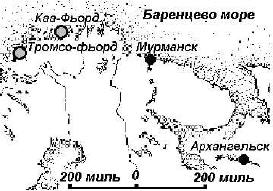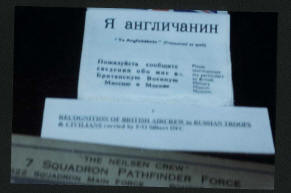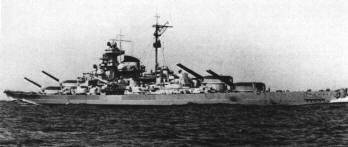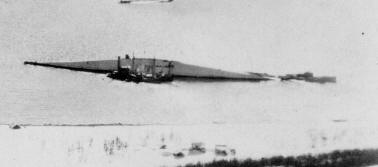Vladimir
Kroupnik
END OF "TIRPITZ"
 The historians of RAAF till now
proudly note that Australian airmen took part in sinking of the biggest ship
of Kriegsmarine. Some of them visited Russia in 1944 in the ranks of an air
group which successfully bombed the mighty battleship from a Soviet base
Yagodnik. A piece of a Russian historian M.N. Suprun was a base for this
page. The author of the site made some additions and wants to express his
gratitude to Igor Gostev (Archangelsk, Russia) for his great help in collecting
of data for this page. In the beginning of it - picture of an English artist
Frank Wootton "Sinking of Tirpitz" (Royal
Air Force Benevolent Fund)
The historians of RAAF till now
proudly note that Australian airmen took part in sinking of the biggest ship
of Kriegsmarine. Some of them visited Russia in 1944 in the ranks of an air
group which successfully bombed the mighty battleship from a Soviet base
Yagodnik. A piece of a Russian historian M.N. Suprun was a base for this
page. The author of the site made some additions and wants to express his
gratitude to Igor Gostev (Archangelsk, Russia) for his great help in collecting
of data for this page. In the beginning of it - picture of an English artist
Frank Wootton "Sinking of Tirpitz" (Royal
Air Force Benevolent Fund)
In the end of 1943 the British Admiralty
found out that the Germans wee preparing a major naval operation with participation
of battleship. Under an agreement with the Soviet command the 543rd air reconnaissance
group, consisting of three "Photospitfires", moved to the Vaenga-1 air base
in order to enhance surveillance over "Tirpitz". The Spitfires conducted
50 sorties from Soviet air strips in September-November 1943, having done
reconnaissance over the main German naval bases in Northern Norway. Due to
these flights it became possible to warn the Allied headquarters about the
sortie of a German squadron led by "Tirpitz" on the 7th of September. Information
about an operation targeted at destruction of Allied bases on Spitzbergen
was fully confirmed. The British reconnaissance pilots kept their eyes on
the squadron during the whole sortie. Possibly, that's why the Kriegsmarine
command ws made complete the operation before time. In 1943 all aircraft
of the reconnaissance group were handed over to the 18th reconnaissance regiment
of the Northern Fleet Air Force, and the British pilots returned home.
Sending convoys to the Northern Russian
seaports, the British Admiralty feared not without a ground, that they would
become a prey for the Kriegsmarine surface ships. The Royal Navy prepared
an operation on annihilation of "Tirpitz' by an air strike from an aircraft
carrier (operation "Tungsten"). In this connection a group of Spitfires was
moved again to Vaenga-1 in March 1944 to enhance surveillance over "Tirpitz".
The British pilots regularly informed the English mission and the Northern
Fleet headquarters about all movements of German ships. It ws their merit
that in March 1944 after a strike from an aircraft carrier the best ship
of Kriegsmarine was put out of action for four months. The pilots which had
visited Russia, were allowed to wear souvenir Soviet stars along with their
battle awards, and the pilots were very much proud of it. As before, all
planes were handed over to the 118th Soviet air regiment in the end of May
upon the returning of the airmen to Great Britain.


|
A schematic map of the area of combat activities of the
617th and 9th squadrons of RAAF in September-November 1944 (Archangelsk in
the right bottom corner, Kaa-fjord straight below the top in the left corner
and Tromso-fjord is south-west of it)
|
Such badges were worn by British and australian airmen,
which flew over the Soviet territory, in case of an unplanned landing and
encounter with Soviet people:
ß - àíãëè÷àíèí. Ïîæàëóéñòà ñîîáùèòå îáî
ìíå â Áðèòàíñêóþ Âîåííóþ Ìèññèþ â Ìîñêâå (I am an Englishman. Please, inform
the British Military Mission in Moscow about me).
(Author's photo from the RAAF museum in Perth, WA)
|
In September 1944 a new operation on
annihilation of "Tirpitz" was designed (operation "Paravan"). The base of
the German battleship was then out of reach of the Lancaster bombers based
in the North of Great Britain. The German justifiably expected a strike from
north-west and because of it a sudden attack from this direction wouldn't
have been feasible. The RAF Command addressed to the Soviet leadership to
provide an air strip in the Soviet North to conduct a sudden strike on the
german battleship from the south. An appropriate agreement was quickly concluded.
The best bombers units of RAF: the 9th
and 617th Lancaster squadrons were selected for this operation. A photo reconnaissance
plane "Mosquito" from the 540th squadron and two Liberators were also included
into the air group for transportation of technical personnel. The Lancaster
carried super powerful bombs "Tallboys" 12,000 pounds (more than 5t) each.
All airmen of the group had made not less than 60 sorties over the German
territory and had battle awards. One more Lancaster from the 463rd squadron
was included into the group - it had a documentary operators intending to
film the oncoming attack on the mightiest battleship of Kriegsmarine...
On the 11th of September at 21.41 p.m.
the aircraft took off from their air base in Scotland and headed towards Archangelsk.
They were being waited for there. A steamship "I. Kaliayev" (on board of
which airmen of the 151st RAF air wing lived in 1941) had been moved to the
Yagodnik air base for accommodation of the British. Two dugouts for 50 men
each were also built. When it became known that 40 planes instead of 30 would
arrive with passengers as well (all up 334 men), two more dugouts were built
over one day. two cutters and two single engine planes were also allocated
for the british to provide them with communications with town.
On the 12th of September at 6 a.m.
a first lancaster of captain Prier turned out over Yagodnik. The pilot headed
towards the radio station immediately after landing. The Lancasters were
landing blindly, with no two way coordination, because of bad weather conditions
and mismatch between the call sign frequencies of a Soviet and british radio
transmitters. That's why only 31 out of 41 aircraft landed in Yagodnik. Soon
it became known that two planes had landed in Kegostrov, two - in Vaskov,
two - in Onega. One plane landed on each of air strips in Belomorsk, Molotovsk,
Chumbalo-Navoloka and Talagy. All these aircraft required small repairs.
fortunately, none of the airmen was seriously injured. The crew of lieutenant
Killy, which landed in a swamp near the Talagy village, was the unluckiest.
A paratrooper guide, who led the crew to a river where a hydroplane was waiting
for them, had to be landed nearby. Four Lancasters flew over to Yagodnik
some hours later. Six remained on the places of landing.
The airmen spent their first day on
the Russian soil on preparation of the aircraft to the operation, on search
of lost crews and securing of bombs thrown by Lancasters near Molotovsk and
Lapominky during forced landing. On the 13th of September the hosts decided
to get familiarized with unknown to them "best English machines". The Soviet
engines and technicians highly appraised the English bombers. Each of them
who was scrutinizing the machines, compiled a detailed report on the observed
for the intelligence department of headquarters. The main attention in the
reports was paid to a "secret" bomb-sight of unknown design, a modernized
astrograph, which was able to estimate automatically a plane's position,
plotting it on sliding film and navigator's map. The Soviet technical personnel
didn't miss out two locators and a small hatch on the right hand side of
the front cockpit. They managed to reveal that it was designed for casting
of foil neutralizing enemy locators. Despite weak protests of the English
side, the Soviet aviators discovered a lot more of interesting and educating
for themselves.
The operation planned for the 14th of
September, was postponed for a day by the British Command. The squadron commanders
were busy specifying the flight route along with the Soviet staff officers.
The crew members were having a rest. An international soccer game took place
that day. Two colonels were amongst the players - chief of headquarters of
the Northern Fleet Air Force Loginov and the commander of the british air
group MacMullen. A military brass arrived to the soccer field and played
a march after each goal. The guests lost 0:6 but were not upset. "Today we
have understood how strong is the foe of the Germans on the Russian front,
- one of the English players said. - Tomorrow they will find out what the
british airmen are capable of".
The 15th of September arrived. Strictly
to the plan at 4.37 a.m. the "Mosquito" reconnaissance plane took off to assess
the weather conditions in the target area. The skies over the Kaa-fjord were
clear. The airmen were in a good mood: each of them considered it as a must
to do a contour flight over the deck of "I. Kaliayev" - their Russian home.
Everybody was so sure of success that there was no fighter cover...
At 10.00 a.m. the Lancasters set their
course and at 3.57 p.m. they were over the target. The enemy AA guns kept
silent. Suddenly one of the planes, which was flying let of the flag one,
left the formation and headed towards "Tirpitz". The flight order was broken
and the flight leader lieutenant colonel Tait had to lead the group for another
circle. The surprise factor was lost. It took the enemy two minutes to set
up a smoke screen with a help of special pipeline circling the fjord. Nevertheless,
the mast tops of "Tirpitz' were still seen and the british attacked the battleship
having thrown about 90 tons of bombs. One straight hit on the bow part of
the ship was achieved and, apart from it, the hull of the ship wa damaged
by explosions of bombs which had fallen next to it. At 4.04 p.m. The aircraft
set a return course and in three hours landed with no losses.
 Several Australians took part
in this attack - and amongst them a pilot Carey of the 617th squadron whose
plane ws damaged by enemy flak. The only hit on "Tirpitz' was noticed by
an Australian, fight lieutenant Buckham who ws flying the filming crew plane.
he was the only pilot who after the attack led his plane to the Waddington
base in Scotland. Most of his flight was just above the sea in very poor
weather conditions. The flight time from Yagodnik to Waddington made up 14
hours 33 minutes - an absolute record for Lancasters.
Several Australians took part
in this attack - and amongst them a pilot Carey of the 617th squadron whose
plane ws damaged by enemy flak. The only hit on "Tirpitz' was noticed by
an Australian, fight lieutenant Buckham who ws flying the filming crew plane.
he was the only pilot who after the attack led his plane to the Waddington
base in Scotland. Most of his flight was just above the sea in very poor
weather conditions. The flight time from Yagodnik to Waddington made up 14
hours 33 minutes - an absolute record for Lancasters.
|
"Tirpitz" in its better times*
|
The "Mosquito" reconnaissance plane
pilot was so sure that the bombs had missed the target that he even didn't
bother about photography of "Tirpitz". Nobody could confidently say if there
had been a hit. A British reconnaissance plane, having made a sortie over
the Kaa-fjord several days after, failed to locate the battleship. soon after
that the British Intelligence received a radio transmission from a Norwegian
patriot Lindberg who lived in the town of Tromso: "Tirpitz" has arrived in
Tromso, there is a large hole in the bow part of the deck". Five days after
the attack a British reconnaissance plane managed to photograph the results
of bombing. based on the intelligence from Norway and photographs, specialists
estimated that repairs of "Tirpitz" will take at least 9 months. The "Paravan"
operation ended successfully.
The planes began to leave Archangelsk.
On the 7th of September at 10 p.m. a ceremony farewell was given to the last
two leaving planes. the results of bombing had become known by that time
and the airmen were leaving with a feeling of done duty. Six damaged Lancasters
were handed over to the Soviet side without compensation, two of them were
repaired in Kegostrov and later used in transport and reconnaissance aviation...
"Tirpitz" had to move further south
into the Tromso-fjord because of fear of new attacks from Yagodnik. The ship
couldn't move faster than 6 knots and, practically, couldn't make an open
sea anymore. the repairs could be made only in Germany. The German Command
decided to place "Tirpitz' in shallow waters to prevent its sinking. Dredges
began to build dams around the unmoving battleship. Simultaneously about
500 of crew members of the engine compartment were transferred on shore...
The RAF command encountered another
problem - flying conditions over the Tromso-fjord lasted for not more than
a day a week. Nevertheless, the battleship was within a reach of Lancasters
of the 5th air group from air-strips in Scotland. However, more powerful Merlin-24
engines and additional fuel tanks were installed on them. On the 29th of
October a reconnaissance plane transmitted that the weather over the Tromso-fjord
was improving, and 38 Lancasters of the 9th and 617th squadrons took off.
This time heavy clouds filled the fjord half a minute before the attack
and didn't allow an aimed bombing. One Lancaster was seriously damaged by
AA fire during this attack and had to land in Sweden.
 On the 12th of November the same squadrons
at last approached the fjord in clear weather. Australian pilots Kell, Ross,
Sayers and Lee took part in the attack. 29 tallboys were thrown. Several
straight hits decided the fate of "Tirpitz" - the battleship began to list
to the port side and in 10 minute after the attack turned over. In two hours
a reconnaissance plane transmitted that only the ship's bottom was seen above
the water. Australian airman Buckham managed to photograph damaged and listing
"Tirpitz" through the smoke screen and smoke of bomb explosions. Thus the
best ship of Kriegsmarine ended her career.
On the 12th of November the same squadrons
at last approached the fjord in clear weather. Australian pilots Kell, Ross,
Sayers and Lee took part in the attack. 29 tallboys were thrown. Several
straight hits decided the fate of "Tirpitz" - the battleship began to list
to the port side and in 10 minute after the attack turned over. In two hours
a reconnaissance plane transmitted that only the ship's bottom was seen above
the water. Australian airman Buckham managed to photograph damaged and listing
"Tirpitz" through the smoke screen and smoke of bomb explosions. Thus the
best ship of Kriegsmarine ended her career.
|
Bottom of "Tirpitz' is seen above the water
|
* Pictures of "Tirpitz" were taken from web-site Ship Photoes
M.N. Suprun. Britanskiye Korolevskiye
VVS v Rossii, 1941-1945. (Iz sbornika "Severnye konvoi: issledovaniya, vospominaniya,
documety". Vyp.2. – M.: Nauka, 1994)
D. Woodward. Tirpitz. 1953
J. Herrington. Australia in the War of
1939-1945. Air Power Over Europe. 1944-1945. 1963
A. Preston. Battleships. 1981
Back
to contents
 The historians of RAAF till now
proudly note that Australian airmen took part in sinking of the biggest ship
of Kriegsmarine. Some of them visited Russia in 1944 in the ranks of an air
group which successfully bombed the mighty battleship from a Soviet base
Yagodnik. A piece of a Russian historian M.N. Suprun was a base for this
page. The author of the site made some additions and wants to express his
gratitude to Igor Gostev (Archangelsk, Russia) for his great help in collecting
of data for this page. In the beginning of it - picture of an English artist
Frank Wootton "Sinking of Tirpitz" (Royal
Air Force Benevolent Fund)
The historians of RAAF till now
proudly note that Australian airmen took part in sinking of the biggest ship
of Kriegsmarine. Some of them visited Russia in 1944 in the ranks of an air
group which successfully bombed the mighty battleship from a Soviet base
Yagodnik. A piece of a Russian historian M.N. Suprun was a base for this
page. The author of the site made some additions and wants to express his
gratitude to Igor Gostev (Archangelsk, Russia) for his great help in collecting
of data for this page. In the beginning of it - picture of an English artist
Frank Wootton "Sinking of Tirpitz" (Royal
Air Force Benevolent Fund) 
 Several Australians took part
in this attack - and amongst them a pilot Carey of the 617th squadron whose
plane ws damaged by enemy flak. The only hit on "Tirpitz' was noticed by
an Australian, fight lieutenant Buckham who ws flying the filming crew plane.
he was the only pilot who after the attack led his plane to the Waddington
base in Scotland. Most of his flight was just above the sea in very poor
weather conditions. The flight time from Yagodnik to Waddington made up 14
hours 33 minutes - an absolute record for Lancasters.
Several Australians took part
in this attack - and amongst them a pilot Carey of the 617th squadron whose
plane ws damaged by enemy flak. The only hit on "Tirpitz' was noticed by
an Australian, fight lieutenant Buckham who ws flying the filming crew plane.
he was the only pilot who after the attack led his plane to the Waddington
base in Scotland. Most of his flight was just above the sea in very poor
weather conditions. The flight time from Yagodnik to Waddington made up 14
hours 33 minutes - an absolute record for Lancasters.  On the 12th of November the same squadrons
at last approached the fjord in clear weather. Australian pilots Kell, Ross,
Sayers and Lee took part in the attack. 29 tallboys were thrown. Several
straight hits decided the fate of "Tirpitz" - the battleship began to list
to the port side and in 10 minute after the attack turned over. In two hours
a reconnaissance plane transmitted that only the ship's bottom was seen above
the water. Australian airman Buckham managed to photograph damaged and listing
"Tirpitz" through the smoke screen and smoke of bomb explosions. Thus the
best ship of Kriegsmarine ended her career.
On the 12th of November the same squadrons
at last approached the fjord in clear weather. Australian pilots Kell, Ross,
Sayers and Lee took part in the attack. 29 tallboys were thrown. Several
straight hits decided the fate of "Tirpitz" - the battleship began to list
to the port side and in 10 minute after the attack turned over. In two hours
a reconnaissance plane transmitted that only the ship's bottom was seen above
the water. Australian airman Buckham managed to photograph damaged and listing
"Tirpitz" through the smoke screen and smoke of bomb explosions. Thus the
best ship of Kriegsmarine ended her career.